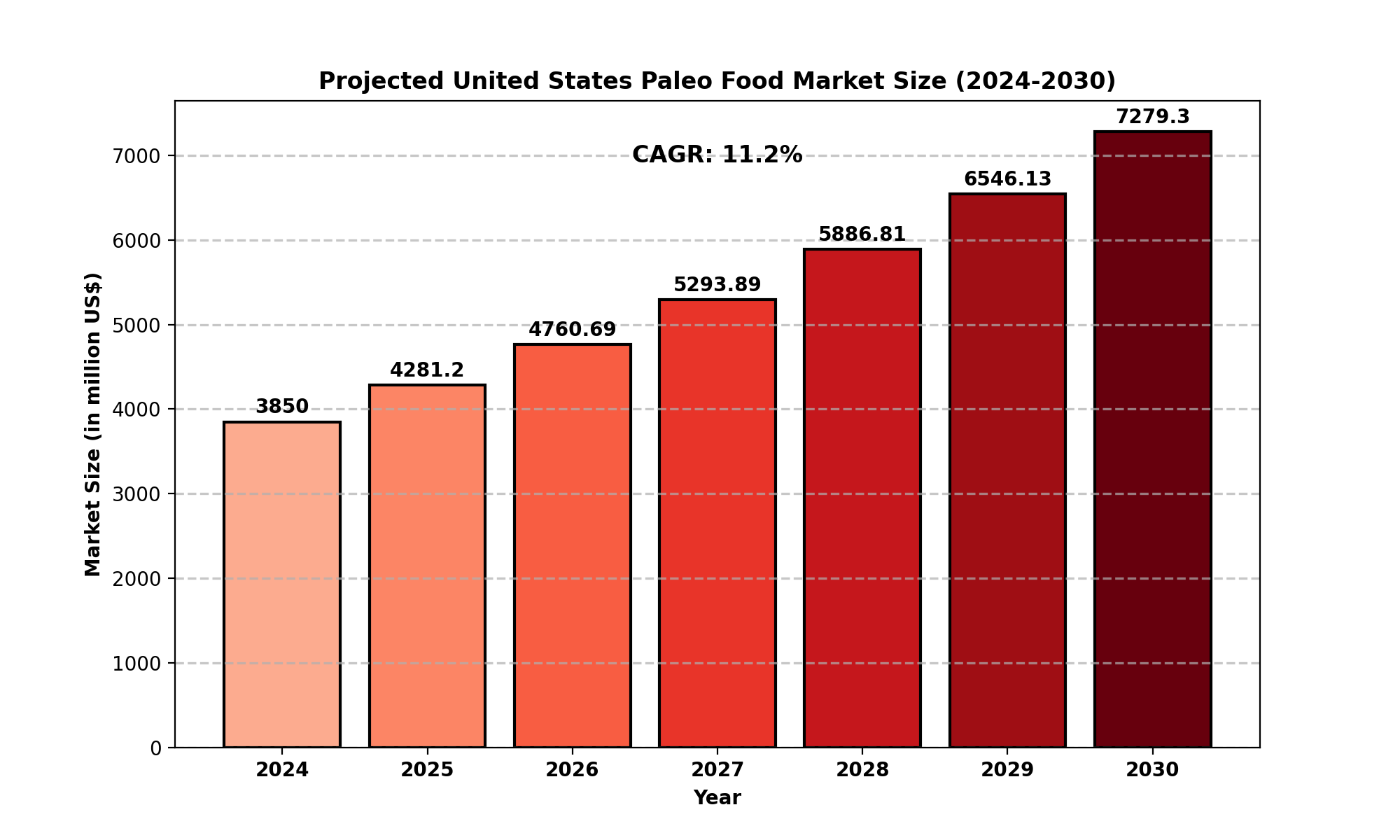The United States Paleo Food market represents a segment of the food industry focused on products that adhere to the principles of the Paleolithic diet. This diet emphasizes natural, unprocessed foods such as meats, fish, fruits, and vegetables while excluding grains, dairy, refined sugars, and processed items. This market caters to health-conscious consumers seeking nutritional benefits aligned with ancestral eating habits.
In 2024, the United States Paleo Food market was valued at US$ 3.85 billion, with projections to reach US$ 7.27 billion by 2030 at a robust compound annual growth rate (CAGR) of 11.2%.
This growth underscores the increasing consumer shift towards clean-label and health-centric food options. Historical data from 2019-2023 highlights steady growth driven by rising health awareness and a preference for minimally processed foods.

Health-Conscious Consumer Trends: Increasing awareness of the benefits of clean eating and ancestral nutrition principles is a primary market driver.
E-commerce Expansion: Direct-to-consumer sales constitute 45% of market revenue, bolstered by specialized e-commerce platforms and subscription services.
Product Innovation: A 62% year-over-year increase in product innovation highlights the industry’s focus on convenient and diverse formats, including snacks and beverages.
Higher Costs: Paleo Food products often come at a premium price due to their reliance on high-quality, organic ingredients, limiting accessibility for some consumers.
Regulatory Hurdles: Achieving and maintaining clean-label certifications and ingredient compliance can be resource-intensive for manufacturers.
Retail Expansion: Distribution networks now encompass over 42,000 retail points, including 15,000 specialty health food stores, presenting opportunities for deeper market penetration.
Export Potential: Expanding export opportunities to European markets, with a 42% growth, reflects increasing global demand.
Sustainability Initiatives: Partnerships with 2,800 organic farms and waste reduction programs offer avenues for sustainable market growth.
Consumer Education: Despite reaching 25 million households through digital channels, educating consumers about the Paleo diet remains critical to market expansion.
Supply Chain Management: Ensuring consistent ingredient sourcing while maintaining high compliance standards poses logistical challenges.
The United States Paleo Food market has seen widespread adoption across key regions:
West Coast: Known for its health-conscious population, the West Coast represents a significant share of the market, driven by urban centers like Los Angeles and San Francisco.
Midwest: Increasing retail penetration and educational campaigns are driving growth in traditionally underserved regions.
East Coast: With a strong emphasis on organic and natural foods, cities like New York and Boston contribute significantly to market demand.
The competitive landscape is defined by key players emphasizing innovation, quality, and compliance:
Primal Kitchen: Known for its sauces and dressings adhering to Paleo principles.
Epic Provisions: Specializes in meat-based snacks.
RxBar: Offers clean-label protein bars.
Steve’s PaleoGoods: Provides diverse Paleo snacks and beverages.
Other notable companies include Caveman Foods, The New Primal, Bare Bones Broth, and Wild Zora.
This report provides a deep insight into the United States Paleo Food market, covering all its essential aspects. From a macro overview to micro details, the report highlights the competitive landscape, development trends, key market drivers, and challenges. It serves as a valuable resource for stakeholders to evaluate market positioning and strategize for future growth.
Supermarkets and Hypermarkets
Convenience Stores
Specialist Retailers
Online Retailers
Cereals, Bakery Products, and Snacks
Sports Nutrition and Beverages
Primal Kitchen
Paleo Pro
Caveman Foods
Steve's PaleoGoods
Epic Provisions
The New Primal
RxBar
Paleo on the Go
Bare Bones Broth
Wild Zora
West Coast
Midwest
East Coast
Key Indicators Analysed
Key Benefits of This Market Research:
Key Reasons to Buy this Report:
We offer additional regional and global reports that are similar:
Customization of the Report: In case of any queries or customization requirements, please connect with our sales team, who will ensure that your requirements are meet.
1.1 Paleo Food Product Introduction
1.2.1 United Statesn Paleo Food Market Size Growth Rate by Type, 2019 VS 2023 VS 2030
1.2.2 Cereals, Bakery Products, and Snacks
1.2.3 Sports Nutrition and Beverages
1.3.1 United States Paleo Food Market Size Growth Rate by Application, 2019 VS 2023 VS 2030
1.3.2 Supermarkets and Hypermarkets
1.3.3 Convenience Stores
1.3.4 Specialist Retailers
1.3.5 Online Retailers
1.4 United States Paleo Food Sales Estimates and Forecasts 2019-2030
1.5 United States Paleo Food Hydrocephalus Shunts Revenue Estimates and Forecasts 2019-2030
1.6 Study Objectives
1.7 Years Considered
2.1 United States Paleo Food Sales by Manufacturers
2.1.1 United States Paleo Food Sales by Manufacturers (2019-2024)
2.1.2 United States Paleo Food Sales Market Share by Manufacturers (2019-2024)
2.1.3 Top Largest Manufacturers of Paleo Food in 2023 in United States
2.2 United States Paleo Food Revenue by Manufacturers
2.2.1 United States Paleo Food Revenue by Manufacturers (2019-2024)
2.2.2 United States Paleo Food Revenue Market Share by Manufacturers (2019-2024)
2.2.3 United States Top Companies by Paleo Food Revenue in 2023
2.3 United States Paleo Food Sales Price by Manufacturers (2019-2024)
2.4 Analysis of Competitive Landscape
2.4.1 Manufacturers Market Concentration Ratio (CR3 and HHI)
2.4.2 United States Paleo Food by Company Type (Tier 1, Tier 2, and Tier 3)
2.4.3 United States Paleo Food Manufacturers Geographical Distribution
2.5 Mergers & Acquisitions, Expansion Plans
3.1 Paleo Food Market Size by Region: 2019-2030
3.1.1 United States Paleo Food Sales by Region: 2019-2024
3.1.2 United States Paleo Food Sales Forecast by Region (2025-2030)
3.1.3 United States Paleo Food Revenue by Region: 2019-2024
3.1.4 United States Paleo Food Revenue Forecast by Region (2025-2030)
4.1 United States Paleo Food Sales by Type
4.1.1 United States Paleo Food Historical Sales by Type (2019-2024)
4.1.2 United States Paleo Food Forecasted Sales by Type (2025-2030)
4.1.3 United States Paleo Food Sales Market Share by Type (2019-2030)
4.2 United States Paleo Food Revenue by Type
4.2.1 United States Paleo Food Historical Revenue by Type (2019-2024)
4.2.2 United States Paleo Food Forecasted Revenue by Type (2025-2030)
4.2.3 United States Paleo Food Revenue Market Share by Type (2019-2030)
4.3 United States Paleo Food Price by Type
4.3.1 United States Paleo Food Price by Type (2019-2024)
4.3.2 United States Paleo Food Price Forecast by Type (2025-2030)
5.1 United States Paleo Food Sales by Application
5.1.1 United States Paleo Food Historical Sales by Application (2019-2024)
5.1.2 United States Paleo Food Forecasted Sales by Application (2025-2030)
5.1.3 United States Paleo Food Sales Market Share by Application (2019-2030)
5.2 United States Paleo Food Revenue by Application
5.2.1 United States Paleo Food Historical Revenue by Application (2019-2024)
5.2.2 United States Paleo Food Forecasted Revenue by Application (2025-2030)
5.2.3 United States Paleo Food Revenue Market Share by Application (2019-2030)
5.3 United States Paleo Food Price by Application
5.3.1 United States Paleo Food Price by Application (2019-2024)
5.3.2 United States Paleo Food Price Forecast by Application (2025-2030)
6.1 Primal Kitchen
6.1.1 Primal Kitchen Corporation Information
6.1.2 Primal Kitchen Overview
6.1.3 Primal Kitchen in United States: Paleo Food Sales, Price, Revenue and Gross Margin (2019-2024)
6.1.4 Primal Kitchen Paleo Food Product Introduction
6.1.5 Primal Kitchen Recent Developments
6.2 Paleo Pro
6.2.1 Paleo Pro Corporation Information
6.2.2 Paleo Pro Overview
6.2.3 Paleo Pro in United States: Paleo Food Sales, Price, Revenue and Gross Margin (2019-2024)
6.2.4 Paleo Pro Paleo Food Product Introduction
6.2.5 Paleo Pro Recent Developments
6.3 Caveman Foods
6.3.1 Caveman Foods Corporation Information
6.3.2 Caveman Foods Overview
6.3.3 Caveman Foods in United States: Paleo Food Sales, Price, Revenue and Gross Margin (2019-2024)
6.3.4 Caveman Foods Paleo Food Product Introduction
6.3.5 Caveman Foods Recent Developments
6.4 Steve's PaleoGoods
6.4.1 Steve's PaleoGoods Corporation Information
6.4.2 Steve's PaleoGoods Overview
6.4.3 Steve's PaleoGoods in United States: Paleo Food Sales, Price, Revenue and Gross Margin (2019-2024)
6.4.4 Steve's PaleoGoods Paleo Food Product Introduction
6.4.5 Steve's PaleoGoods Recent Developments
6.5 Epic Provisions
6.5.1 Epic Provisions Corporation Information
6.5.2 Epic Provisions Overview
6.5.3 Epic Provisions in United States: Paleo Food Sales, Price, Revenue and Gross Margin (2019-2024)
6.5.4 Epic Provisions Paleo Food Product Introduction
6.5.5 Epic Provisions Recent Developments
6.6 The New Primal
6.6.1 The New Primal Corporation Information
6.6.2 The New Primal Overview
6.6.3 The New Primal in United States: Paleo Food Sales, Price, Revenue and Gross Margin (2019-2024)
6.6.4 The New Primal Paleo Food Product Introduction
6.6.5 The New Primal Recent Developments
6.7 RxBar
6.7.1 RxBar Corporation Information
6.7.2 RxBar Overview
6.7.3 RxBar in United States: Paleo Food Sales, Price, Revenue and Gross Margin (2019-2024)
6.7.4 RxBar Paleo Food Product Introduction
6.7.5 RxBar Recent Developments
6.8 Paleo on the Go
6.8.1 Paleo on the Go Corporation Information
6.8.2 Paleo on the Go Overview
6.8.3 Paleo on the Go in United States: Paleo Food Sales, Price, Revenue and Gross Margin (2019-2024)
6.8.4 Paleo on the Go Paleo Food Product Introduction
6.8.5 Paleo on the Go Recent Developments
6.9 Bare Bones Broth
6.9.1 Bare Bones Broth Corporation Information
6.9.2 Bare Bones Broth Overview
6.9.3 Bare Bones Broth in United States: Paleo Food Sales, Price, Revenue and Gross Margin (2019-2024)
6.9.4Bare Bones Broth Paleo Food Product Introduction
6.9.5 Bare Bones Broth Recent Developments
6.10 Wild Zora
6.10.1 Wild Zora Corporation Information
6.10.2 Wild Zora Overview
6.10.3 Wild Zora in United States: Paleo Food Sales, Price, Revenue and Gross Margin (2019-2024)
6.10.4 Wild Zora Paleo Food Product Introduction
6.10.5 Wild Zora Recent Developments
7.1 Paleo Food Industry Chain Analysis
7.2 Paleo Food Key Raw Materials
7.2.1 Key Raw Materials
7.2.2 Raw Materials Key Suppliers
7.3 Paleo Food Production Mode & Process
7.4 Paleo Food Sales and Marketing
7.4.1 Paleo Food Sales Channels
7.4.2 Paleo Food Distributors
7.5 Paleo Food Customers
8.1.1 Paleo Food Industry Trends
8.1.2 Paleo Food Market Drivers
8.1.3 Paleo Food Market Challenges
8.1.4 Paleo Food Market Restraints
10.1 Research Methodology
10.1.1 Methodology/Research Approach
10.1.2 Data Source
10.2 Author Details
10.3 Disclaimer
Frequently Asked Questions ?
